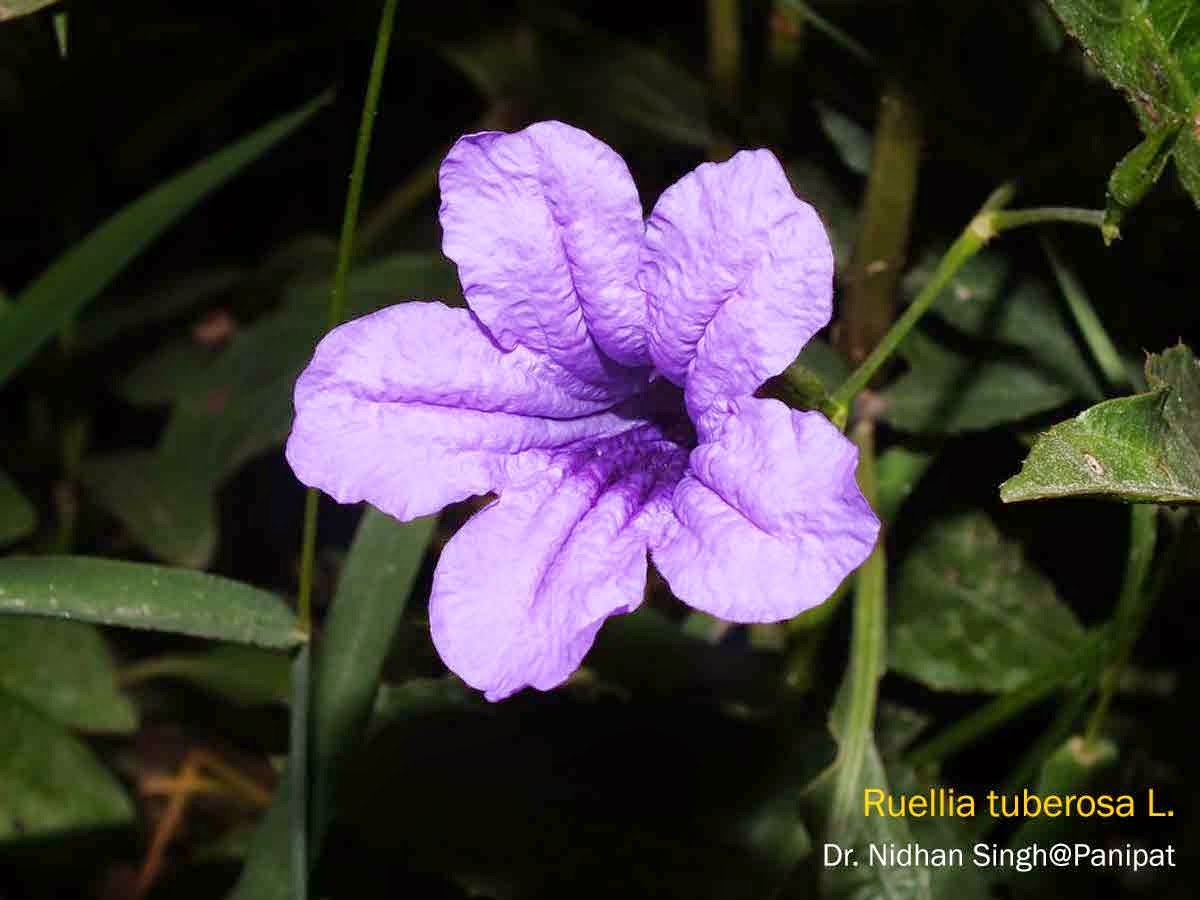 Ruellia tuberosa L.
Ruellia tuberosa L.Family: Acanthaceae
Synonyms: Cryphiacanthus barbadensis Nees, Dipteracanthus clandestinus C.Presl
Common name: Waterkanon, Watrakanu, Minnie Root, Iron root, Feverroot, Popping pod,
Chinese: 块根芦莉草
Javanese: Ceplikan
Marathi: Ruwel
Tamil: Pattaskai பட்டாஸ்காய்
Thai: ต้อยติ่ง
Hindi: chatpati चट्पटि
Telugu: chetapatakaayala mokka చిటపటకాయల మొక్క,
Other names: ghabri, jalvarkur, jurbula, ote sirka ba, tapas kaaya
Description: An erect, up to 60 (-70) cm tall herb with stout, 4-angled stems, swollen and purplish at the nodes, tender parts sparsely hairy. Roots slender, elongated, tuberous. Leaves with up to 2 cm long petiole; lamina oblong-obovate to oblanceolate, 5-9 (-10) x 2-4 cm, shining, basally cuneate to attenuate, entire to ± undulate, obtuse to somewhat acute, often mucronulate. Flowers shortly pedicellate, blue-violet, showy, 5-5.5 cm long, c. 3.5 cm across, solitary or in 1-3-flowered, terminal or axillary cymes; bracts and bracteoles linear-lanceolate, c. 5 mm long. Calyx lobes ± equal, linear, 1.3-2 cm long, ciliate, acute. Corolla pubescent outside, tube c. 3.5 cm long, abruptly narrowed at base, limb 5-lobed, lobes ± equal, ovate, c. 1.5 cm long, patent. Stamens with oblong-sagittate, c. 4 mm long, puberulous anthers. Ovary oblong, c. 4 mm long, glabrous; style 2.3-2.5 cm long. Capsule oblong, 2.2-3 cm long, glabrous or scabrescent, 24-28-seeded, minutely beaked at tip. Seeds flattened, orbicular, c. 2 mm across, hairy.
Plant decoction antacid, in indigestion and stomachache; plant and roots decoction taken internally for urinary troubles. Leaf paste for eczema; leaf decoction drunk by pregnant women for cold in the body. Roots infusion for oliguria, heat, fever, influenza, venereal diseases, constipation; root decoction diuretic and aphrodisiac. A paste made of root and few peppers is taken to cure stomachache. Tuber poultice for
swelling, joint pain. [CRC World Dictionary of Medicinal and Poisonous Plants]
Purgative and causes perspiration [Women’s Knowledge of Herbs used in Reproduction in Trinidad and Tobago. Ethnomedicinal Plants Revitalization of Traditional Knowledge of Herbs]
Brazilians mix leaves with castor oil for skin eruptions blamed on teething, Cubans, considering roots and leaves diuretic, emetic, and purgative, use also for malaria, peritonitis, pneumonia, and whooping cough. Dominicans use macerated roots for leukorrhea and pelvic pain. Dominicans use the plant as analgesic, antiseptic, diaphoretic, diuretic, and febrifuge, for cough, cystosis, fever, and pertussis. Guadelupans use as diuretic, taking 2 tsp–1.5 tbsp dry herb/half bottle Spanish wine for jaundice. Haitians use leaf, flower, and root as diuretic, in decoction. Peruvians suggest the infusion for bronchosis, flu, gonorrhea, headache, inflammation, leprosy, oliguria, pain, and wounds. Venezuelans use root decoction for asthma, blennorrhagia, catarrh, and pulmonosis. [ Duke's Handbook of Medicinal Plants of Latin America]
A decoction is given in chronic bronchitis; also used as a diuretic for the treatment of stones in the bladder. [Indian Medicinal Plants - Ayurveda]
Whole plant: To treat bladder diseases and frequent micturition; decoction with Petiveria alliacea is drunk to "clean out" uterine tract (dilation and curettage) or as an abortifacient. Root: Infusion for kidney diseases; in a syrup for whooping cough; infusion or decoction for a diabetes remedy; tubers in a tea used for cleansing the blood. Root and Leaf: In a tea used for alleviating retention of urine and to remedy weakness. [Medicinal Plants of the Guianas (Guyana, Surinam, French Guiana)
Diuretic, antitoxic, abdominal pain, flu, hepatitis, high blood pressure, diabetes [Taiwanese Native Medicinal Plants]
swelling, joint pain. [CRC World Dictionary of Medicinal and Poisonous Plants]
Purgative and causes perspiration [Women’s Knowledge of Herbs used in Reproduction in Trinidad and Tobago. Ethnomedicinal Plants Revitalization of Traditional Knowledge of Herbs]
Brazilians mix leaves with castor oil for skin eruptions blamed on teething, Cubans, considering roots and leaves diuretic, emetic, and purgative, use also for malaria, peritonitis, pneumonia, and whooping cough. Dominicans use macerated roots for leukorrhea and pelvic pain. Dominicans use the plant as analgesic, antiseptic, diaphoretic, diuretic, and febrifuge, for cough, cystosis, fever, and pertussis. Guadelupans use as diuretic, taking 2 tsp–1.5 tbsp dry herb/half bottle Spanish wine for jaundice. Haitians use leaf, flower, and root as diuretic, in decoction. Peruvians suggest the infusion for bronchosis, flu, gonorrhea, headache, inflammation, leprosy, oliguria, pain, and wounds. Venezuelans use root decoction for asthma, blennorrhagia, catarrh, and pulmonosis. [ Duke's Handbook of Medicinal Plants of Latin America]
A decoction is given in chronic bronchitis; also used as a diuretic for the treatment of stones in the bladder. [Indian Medicinal Plants - Ayurveda]
Whole plant: To treat bladder diseases and frequent micturition; decoction with Petiveria alliacea is drunk to "clean out" uterine tract (dilation and curettage) or as an abortifacient. Root: Infusion for kidney diseases; in a syrup for whooping cough; infusion or decoction for a diabetes remedy; tubers in a tea used for cleansing the blood. Root and Leaf: In a tea used for alleviating retention of urine and to remedy weakness. [Medicinal Plants of the Guianas (Guyana, Surinam, French Guiana)
Diuretic, antitoxic, abdominal pain, flu, hepatitis, high blood pressure, diabetes [Taiwanese Native Medicinal Plants]
